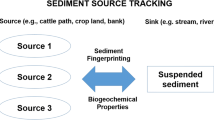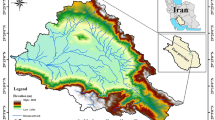Abstract
Purpose
Recent sediment fingerprinting research has shown the sensitivity of source apportionment results to data treatments, tracer number, and mixing model type. In light of these developments, there is a need to revisit procedures associated with tracer selection in sediment fingerprinting studies. Here, we evaluate the accuracy and precision of different procedures to select tracers for un-mixing sediment sources.
Materials and methods
We present a new approach to tracer selection based on identifying and removing tracers that exhibit non-conservative behaviour during sediment transport. This removes tracers on the basis of non-conservative behaviour identified using (1) tracer-particle size relationships and (2) source mixing polygons. We test source apportionment results using six sets of tracers with three different synthetic mixtures comprising one, five, and ten mixture samples. Source tracer data was obtained from an agricultural catchment in northwest England where time-integrated suspended sediment samples were also collected over a 12-month period. Source un-mixing used MixSIAR, a Bayesian mixing model developed for ecological food web studies, which is increasingly being applied in catchment sediment fingerprinting research.
Results and discussion
We found that the most accurate source apportionment results were achieved by the selection procedure that only removed tracers on the basis of non-conservative behaviour. Furthermore, accuracy and precision were improved with five or ten mixture samples compared to the use of a single mixture sample. Combining this approach with a further step to exclude additional tracers based on source group non-normality reduced accuracy, which supports relaxation of the assumption of source normality in MixSIAR. Source apportionment based on the widely used Kruskal-Wallis H test and discriminant function analysis approach was less accurate and had larger uncertainty that the procedure focused on excluding non-conservative tracers.
Conclusions
Source apportionment results are sensitive to tracer selection. Our findings show that prioritising tracer exclusion due to non-conservative behaviour produces more accurate results than selection based on the minimum number of tracers that maximise source discrimination. Future sediment fingerprinting studies should aim to maximise the number of tracers used in source un-mixing constrained only by the need to ensure conservative behaviour. Our procedure provides a quantitative approach for identifying and excluding those non-conservative tracers.









Similar content being viewed by others

References
Bini C, Sartori G, Wahsha M, Fontana S (2011) Background levels of trace elements and soil geochemistry at regional level in NE Italy. J Geochem Explor 109:125–133
Bivand RS, Pebesma E, Gomez-Rubio V (2013) Applied spatial data analysis with R, 2nd edn. Springer, New York http://www.asdar-book.org/
Blake L, Goulding KWT (2002) Effects of atmospheric deposition, soil pH and acidification on heavy metal content in soils and vegetation of semi-natural ecosystems at Rothamsted Experimental Station, UK. Plant Soil 240:235–251
Blonder B, Lamanna C, Violle C, Enquist BJ (2014) The n-dimensional hypervolume. Glob Ecol Biogeogr 23:595–609
Collins AL, Walling DE (2002) Selecting fingerprint properties for discriminating potential suspended sediment sources in river basins. J Hydrol 261:218–244
Collins AL, Walling DE, Leeks GJL (1997) Source type ascription for fluvial suspended sediment based on a quantitative composite fingerprinting technique. Catena 29:1–27
Collins AL, Pulley S, Foster IDL, Gellis A, Porto P, Horowitz AJ (2017) Sediment source fingerprinting as an aid to catchment management: a review of the current state of knowledge and a methodological decision-tree for end-users. J Environ Manag 194:86–108
Cooper RJ, Krueger T (2017) An extended Bayesian sediment fingerprinting mixing model for the full Bayes treatment of geochemical uncertainties. Hydrol Process 31:1900–1912
Cooper RJ, Krueger T, Hiscock KM, Rawlins BG (2014) Sensitivity of fluvial sediment source apportionment to mixing model assumptions. Water Resour Res 50:9031–9047
D’Haen K, Verstraeten G, Duser B, Degryse P, Haex J, Waelkens M (2013) Unravelling changing sediment sources in a Mediterranean mountain catchment: a Bayesian fingerprinting approach. Hydrol Process 27:896–910
Dawson BSW, Fergusson JE, Campbell AS, Cutler EJB (1991) Depletion of first-row transition metals in a chronosequence of soils in the Reefton area of New Zealand. Geoderma 48:271–296
Fox JF, Papanicolaou AN (2008) An un-mixing model to study watershed erosion processes. Adv Water Resour 31:96–108
Franks SW, Rowan JS (2000) Multi-parameter fingerprinting of sediment sources: uncertainty estimation and tracer selection. In: Bentley LR (ed) Computational methods in water resources XIII. Balkema, Rotterdam, pp 1067–1074
Haddadchi A, Olley J, Laceby P (2014) Accuracy of mixing models in predicting sediment source contributions. Sci Total Environ 497-498:139–152
Hay KL, Dearing JA, Baban SMJ, Loveland P (1997) A preliminary attempt to identify atmospherically-derived pollution particles in English topsoils from magnetic susceptibility measurements. Phys Chem Earth 22:207–210
He Q, Walling DE (1996) Interpreting particle size effects in the adsorption of 137Cs and unsupported 210Pb by mineral soils and sediments. J Environ. Radioact 30:117–113
Jobbágy EG, Jackson RB (2001) The distribution of soil nutrients with depth: global patterns and the imprint of plants. Biogeochemistry 53:51–77
Kassambara A, Mundt F (2017) factoextra: extract and visualize the results of multivariate data analyses. R package version 1.0.4. https://CRAN.R project.org/package=factoextra
Koiter AJ, Owens PN, Petticrew EL, Lobb DA (2013) The behavioural characteristics of sediment properties and their implications for sediment fingerprinting as an approach for identifying sediment sources in river basins. Earth-Sci Rev 125:24–42
Kříbek B, Majer V, Veselovský F, Nyambe I (2010) Discrimination of lithogenic and anthropogenic sources of metals and sulphur in soils of the central-northern part of the Zambian Copperbelt Mining District: a topsoil vs. subsurface soil concept. J Geochem Explor 104:69–86
Laceby JP, Evrard O, Smith HG, Blake WH, Olley JM, Minella JPG, Owens PN (2017) The challenges and opportunities of addressing particle size effects in sediment source fingerprinting: a review. Earth-Sci Rev 169:85–103
Le S, Josse J, Husson F (2008) FactoMineR: an R package for multivariate analysis. J Stat Softw 25:1–18
Martínez-Carreras N, Udelhoven T, Krein A, Gallart F, Iffly JF, Ziebel J, Hoffmann L, Pfister L, Walling DE (2010) The use of sediment colour measured by diffuse reflectance spectrometry to determine sediment sources: application to the Attert River catchment (Luxembourg). J Hydrol 382:49–63
Moore JW, Semmens BX (2008) Incorporating uncertainty and prior information into stable isotope mixing models. Ecol Lett 11:470–480
Nosrati K, Govers G, Semmens BX, Ward EJ (2014) A mixing model to incorporate uncertainty in sediment fingerprinting. Geoderma 217-218:173–180
Owens PN, Blake WH, Gaspar L, Gateuille D, Koiter AJ, Lobb DA, Petticrew EL, Reiffarth DG, Smith HG, Woodward JC (2016) Fingerprinting and tracing the sources of soils and sediments: earth and ocean science, geoarchaeological, forensic, and human health applications. Earth-Sci Rev 162:1–23
Palazón L, Latorre B, Gaspar L, Blake WH, Smith HG, Navas A (2015) Comparing catchment sediment fingerprinting procedures using an auto-evaluation approach with virtual sample mixtures. Sci Total Environ 532:456–466
Parnell AC, Inger R, Bearhop S, Jackson AL (2010) Source partitioning using stable isotopes: coping with too much variation. PLoS One 5:e9672
Parnell AC, Phillips DL, Bearhop S, Semmens BX, Ward EJ, Moore JW, Jackson AL, Grey J, Kelly DJ, Inger R (2013) Bayesian stable isotope mixing models. Environmetrics 24:387–399
Pebesma EJ, Bivand RS (2005) Classes and methods for spatial data in R. R News 5(2). https://cran.r-project.org/doc/Rnews/
Phillips JM, Russell MA, Walling DE (2000) Time-integrated sampling of fluvial suspended sediment: a simple methodology for small catchments. Hydrol Process 14:2589–2602
Pulley S, Foster I, Collins AL (2017) The impact of catchment source group classification on the accuracy of sediment fingerprinting outputs. J Environ Manag 194:16–26
R Core Team (2017) R: a language and environment for statistical computing. R Foundation for Statistical Computing, Vienna https://www.R-project.org/
Rowland CS, Morton RD, Carrasco L, McShane G, O’Neil AW, Wood CM (2017) Land cover map 2015 (vector, GB). NERC Environmental Information Data Centre https://doi.org/10.5285/6c6c9203-7333-4d96-88ab-78925e7a4e73
RStudio Team (2016) RStudio: integrated development for R. RStudio Inc., Boston http://www.rstudio.com/
Sherriff SC, Franks SW, Rowan JS, Fenton O, Ó’hUallacháin D (2015) Uncertainty-based assessment of tracer selection, tracer non-conservativeness and multiple solutions in sediment fingerprinting using synthetic and field data. J Soils Sediments 15:2101–2116
Smith HG, Blake WH (2014) Sediment fingerprinting in agricultural catchments: a critical re-examination of source discrimination and data corrections. Geomorphology 204:177–191
Stock BC, Semmens BX (2016a) MixSIAR GUI User Manual version 3.1. https://github.com/brianstock/MixSIAR. https://doi.org/10.5281/zenodo.56159
Stock BC, Semmens BX (2016b) Unifying error structures in commonly used biotracer mixing models. Ecology 97:2562–2569
Taylor A, Blake WH, Smith HG, Mabit L, Keith-Roach MJ (2013) Assumptions and challenges in the use of fallout beryllium-7 as a soil and sediment tracer in river basins. Earth-Sci Rev 126:85–95
Tyler G (2004) Vertical distribution of major, minor and rare elements in a Haplic Podzol. Geoderma 119:277–290
Upadhayhay HR, Bodé S, Griepentrog M, Huygens D, Bajracharya RM, Blake WH, Dercon G, Mabit L, Gibbs M, Semmens BX, Stock BC, Cornelis W, Boeckx P (2017) Methodological perspectives on the application of compound-specific stable isotope fingerprinting for sediment source apportionment. J Soils Sediments 17:1537–1553
Venables WN, Ripley BD (2002) Modern applied statistics with S, 4th edn. Springer, New York ISBN 0-387-95457-0
Wallbrink PJ, Murray AS, Olley JM (1999) Relating suspended sediment to its original depth using fallout radionuclides. Soil Sci Soc Am J 63:369–378
Walling DE (2013) The evolution of sediment source fingerprinting investigations in fluvial systems. J Soils Sediments 13:1658–1675
Ward EJ, Semmens BX, Schindler DE (2010) Including source uncertainty and prior information in the analysis of stable isotope mixing models. Environ Sci Technol 44:4645–4650
Weihs C, Ligges U, Luebke K, Raabe N (2005) klaR analyzing German business cycles. In: Baier D, Decker R, Schmidt-Thieme L (eds) Data analysis and decision support. Springer-Verlag, Berlin, pp 335–343
Acknowledgements
Field and laboratory assistance from Poonperm Vardhanabindu, Chris Feeney, Sión Regan, and Chris Cakebread is much appreciated. We also gratefully acknowledge the support of Gareth Jones and Paul Peters from the Ribble Rivers Trust for collecting and maintaining the suspended sediment samplers. We thank the three anonymous reviewers for their comments that helped improve the manuscript.
Funding
We acknowledge funding from the Malaysian Government Ministry of Higher Education (MOHE) for the visit by DSK to Liverpool and support for HGS and ATL from the European Commission Horizon 2020 programme under the Marie Skłodowska-Curie Research and Innovation Staff Exchange programme (IMIXSED project: Integrating isotopic techniques with Bayesian modelling for improved assessment and management of global sedimentation problems Project ID 644320).
Author information
Authors and Affiliations
Corresponding author
Additional information
Responsible editor: David Allen Lobb
Electronic supplementary material
ESM 1
(PDF 1295 kb)
Rights and permissions
About this article
Cite this article
Smith, H.G., Karam, D.S. & Lennard, A.T. Evaluating tracer selection for catchment sediment fingerprinting. J Soils Sediments 18, 3005–3019 (2018). https://doi.org/10.1007/s11368-018-1990-7
Received:
Accepted:
Published:
Issue Date:
DOI: https://doi.org/10.1007/s11368-018-1990-7



